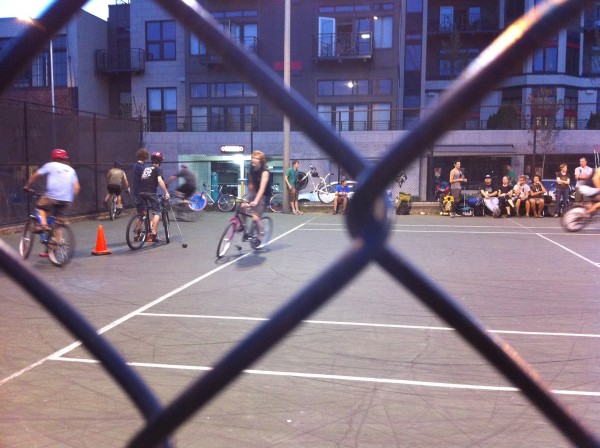 Capitol Hill Seattle reports that Dennis Cook, the Athletics Manager for Seattle Parks, has recommended banning bike polo, but not dodgeball, from Cal Anderson tennis courts:
Capitol Hill Seattle reports that Dennis Cook, the Athletics Manager for Seattle Parks, has recommended banning bike polo, but not dodgeball, from Cal Anderson tennis courts:
The recommendations call for the creation of three tiers of classifications for sports courts in the city based on how many courts are at a location, the surface at the location and whether area high schools use the court for match play. The first tier courts such as Lower Woodland and Lincoln Park would not allow alternative uses while second tier courts including Cal Anderson and Green Lake will be open to alternative uses not including wheels or sticks. The hockey and the polo crowd will have to stick to tier three courts with concrete surfaces like Judkins or Dearborn Park.
While the recommendations represent a victory for dodgeball organizers, the Capitol Hill bike polo crowd will either have to continue their rebel play or move on. These organized matches also take place at TT Minor Elementary School just up Madison from Pike/Pine and the Green Lake park and ride. Players will also be gathering this weekend at Judkins Park for the Emerald City Open .
— Advertisement —
As we’ve written about before, hardcourt bike polo’s popularity has grown substantially in the past couple years, and the game calls Seattle home. Cal Anderson is certainly the game’s most iconic venue. During a game, the most common reaction from passers by is, “Woah! That’s so cool!”
The suggested ban comes from a memo to the Board of Parks Commissioners, a citizen advisory group that meets regularly to help guide the Department of Parks and Recreation. They will meet at 7 p.m. Thursday at 100 Dexter Ave N to discuss their recommendation to the department. Public comment is still open for the rest of today, so email your thoughts to Sandy Brooks.
The memo, as posted by CHS:
Criteria for Alternate Use Tennis Courts FINAL 10-25-10








Comments
8 responses to “Parks Athletic Manager suggests banning bike polo from Cal Anderson”
I like that the photo clearly shows all the marks left by the bicycle tires. Can’t imagine why Parks wouldn’t want that on their first- or second-tier courts…
Oh no! Not marks left from bike tires. Made of RUBBER! The same thing tennis shoes are made from! That type of punishment to the courts must be just awful.
Actually, the soles on proper tennis shoes are made of non-marking rubber, and most tennis court rules ban the use of shoes with marking soles on the court.
They’ve been talking about putting something uniquely Capitol Hill on the light rail station blocks in addition to lots of TOD… How about a bike polo ground?
If they need to ban something from Cal Anderson park.. maybe it should be all the CRACK! Encourage youth sports, you freakin’ jerks!
There’s a picture in the men’s bathroom in Cal Anderson park that depicts a group of kids playing street hockey on the tennis courts, where they are now playing bike polo. I find it interesting that although the players of bike polo live, work and shop on Capitol Hill, they would be disallowed from using those public surfaces. They probably pay the same taxes, fees and fines that tennis or dodgeball players do. I say that the use of those courts should be for whoever is using them.
This would be a sad development. The design and management of community facilities needs to adapt to the desire in the community to use them, and not the other way around.
The world is diversifying but we are becoming more creative and innovative in the way we manage our cities. Surfaces and facilities can be easily adapted to multiple uses, benches, basketball hoops, seating and tennis nets can all be incorporated into facilities in a way that does not preclude one use from another.
When a multi purpose facility demonstrates such a high level of demand, it can only be a good thing and demonstrates that more space should be provided throughout the various areas of the city. When these facilities are planned with these principles in mind, the role of management in applying rules and restrictions will be reduced and everyone will be happy.
The costs of these facilities is small compared to other municipal expenditure and the benefits to the city are large.
The emergence of bikepolo is an opportunity for municipal recreation planners to engage with a whole new demographic. This can occur in a way that promotes greater participation in physical activity that more traditional sports cannot.
As a bike polo player from Vancouver, B.C., who has played in Seattle numerous times I have to say that the best thing a city can do to revitalize public space is to have it used. In Vancouver our Parks Dept. listened to the concerns and needs of polo players and understood that we provided a service to the area in which we play. Generally funky and eclectic, the area caters to the latte sippin Sunday shopper and there’s nothing they like more than sitting in the park watching polo players having a blast and soaking in something they can talk about to their friends and coworkers (“Hey, guess what I saw this weekend!”). The area surrounding Cal Anderson has the same potential and I urge the council to be proactive in promoting usage of park space for all healthy user groups.